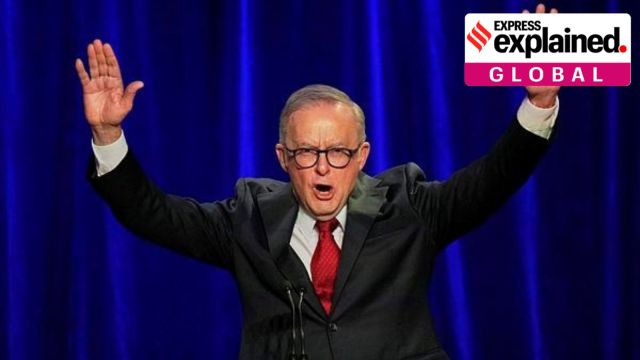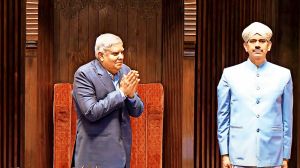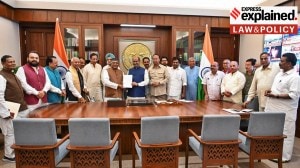How Donald Trump swung Australia’s election — like he did in Canada
The incumbent Labor Party, under Anthony Albanese, will return to power in Australia. Just three months ago, however, things seemed to be headed in a different direction
 Australian Prime Minister Anthony Albanese reacts as he addresses the party faithful after winning a second term following the general election in Sydney, Saturday, May 3, 2025. (AP/PTI)
Australian Prime Minister Anthony Albanese reacts as he addresses the party faithful after winning a second term following the general election in Sydney, Saturday, May 3, 2025. (AP/PTI)The incumbent Labor Party under Prime Minister Anthony Albanese has won the federal elections in Australia.
While votes from Saturday’s (May 3) election are still being counted, early results from the Australian Electoral Commission indicate that the Labor Party was winning 56% of the vote, with the conservative Coalition, comprising the Liberal Party and the National Party, with 44% .
Data from the Australian Broadcasting Corporation indicated that Labor would win 86 seats, 10 more than the 76 it needs to form a majority government, while Coalition, under Peter Dutton, would win 40 overall.
However, only three months ago, things seemed to be headed in a very different direction. Albanese faced the prospect of being the first Australian PM since 1931 to be ousted after only a single three-year term.
This story sounds familiar because it is. Earlier this week, the incumbent Liberal Party in Canada retained power in an election which at the beginning of the year seemed to be in the Conservative’s bag. Behind this stunning turnarounds is one man — US President Donald Trump.
The Canadian story
The Liberals in Canada were staring at imminent defeat at the start of this year.
PM Justin Trudeau was being panned by his constituents and allies alike for failing to address the soaring housing crisis and inflationary pressures. Meanwhile, the Conservative Party, under Pierre Poilievre, had made massive gains over the last couple of years.
At their peak, the Conservatives enjoyed a 20-plus-point lead over the Liberals, as per the Canadian Broadcasting Corporation’s Poll Tracker.
Trudeau resigned on January 6. Trump became the US President on January 20. And everything changed.
This was because Trump repeatedly went after Canada, one of Washington’s closest allies. Not only was Canada one of the first countries to be slapped with the President’s pet tariffs, but Trump also repeatedly called Canada the United States’ “51st state”.
Poilievre, who had long modelled himself as Trump lite, suddenly found himself sinking as “Canadians literally wanted Trump punched in the face”, and the “existential threat” that the US President posed became the primary issue in the election.
On the other hand, Trudeau’s successor, the hailed but politically inexperienced Mark Carney, made attacking Trump his main plank, and galvanised support among the populace for his party.
In the election on April 28, the incumbent Liberals in Canada won 169 seats, three short of the 172 needed for a majority. The Conservatives won 144. Poilievre lost from Carlton, the riding he had been representing since 2004.
Parallels in Australia
On February 1, polls gave the Coalition a voteshare in the 50.4% to 53.6% range, while the Labor Party trailed with 46.4% to 49.5% of the vote, according to data published by The Guardian. The two sides’ graphs converged around March 28, after which the Labor pulled away.
Now Trump’s tariffs have had a more limited impact on this reversal in Australia, compared to Canada, with the island country’s biggest electoral issues still being problems with the country’s universal healthcare system, the high cost of living, and affordable housing.
That said, the sky-high tariffs on China, which imports a third of Australian goods, could hurt Australia. Experts say that for Australia, a largely export-oriented economy, the 145% tariff on its major export market would snowball into reduced demand for its iron ore and copper reserves, a concern amidst a push for renewable energy worldwide.
That said, Dutton too courted Trumpism (something that earned him the moniker “Temu Trump” from critics), and like the US President, criticised woke politics, Australia’s immigration policy, and attacked the national broadcaster.
Most notably, he threatened to slash 41,000 public service jobs — a move he backtracked on only a few days ago — particularly in the education sector. Latest data from the Australian Bureau of Statistics revealed that the Consumer Price Index had risen by 2.4% in March 2025 over the last year, with the largest increase being 5.2% in education.
Australian treasurer and Labor MP, Jim Chalmers, on Saturday called this policy stance the “dumbest move ever”, and considered it the reason Dutton lost his Dickson seat, which he had held for over 20 years.
Australian political commentator and academic, Marija Taflaga, told CNN that Australia is seeing “a diluted version” of the Canada trend, to the incumbent’s advantage.
“Trump has essentially created a rally around the flag effect. In liberal democracies like Australia and Canada, (he’s) flipped the incumbent from being in a disadvantaged position… into an advantageous position,” she said. “Better the devil you know.”
Photos


- 01
- 02
- 03
- 04
- 05



































